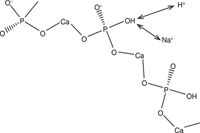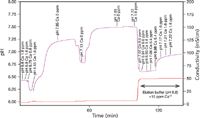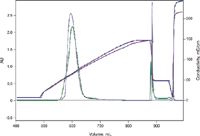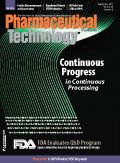Surface Neutralization System
A new, robust method for protein elution from ceramic hydroxyapatite.
Hydroxyapatite is used for the fractionation and purification of a wide variety of biological molecules. At commercial scale, the release of protons during elution can detract from ceramic hydroxyapatite performance. The authors developed a simple methodology using a single additional buffer step called the surface neutralization system (SNS) that removes these protons at near-neutral pH. The insertion of the SNS step does not alter the desirable basic properties of ceramic hydroxyapatite.
Hydroxyapatite is a unique form of calcium phosphate used for the fractionation and purification of a wide variety of biological molecules, such as subclasses of IgG, enzymes, antibody fragments, and nucleic acids (1). Hydroxyapatite chromatography can be used as a polishing step to separate biomolecules that otherwise closely copurify (2–5, 6) or for the initial purification of crude samples (6). Ceramic hdroxyapatite is manufactured through sintering and heat treating hydroxyapatite crystals, thus forming a robust, easy-to-pack beaded form (7).
CHT is a mixed-mode resin. The calcium ions on the surface bind to either carboxyl clusters or phosphoryl groups on target molecules in a metal affinity-type mechanism. The phosphate groups on the surface, on the other hand, interact with amines or other positively-charged groups on the surface of proteins (or other molecules) through a classical cation-exchange mechanism. CHT is used to purify many manufactured biotherapeutics and for general proteins, owing to its superior removal of all process-stream impurities (e.g., aggregates, host-cell protein, viruses, endotoxin, protein A, and DNA).
At commercial scale, the release of protons during elution can hinder CHT performance. The surface of CHT under typical processing conditions has a high degree of protonation on the surface phosphate groups (see Figure 1) (8). These protons can change places with other cations in the mobile phase. When the concentration of cations increases (e.g., step gradients range from low ionic strength to high ionic strength), protons are released into the mobile phase, temporarily reducing the pH of the solution. This release has been mathematically modeled (9). Such uncontrolled pH excursions can, in the long run, detract from CHT performance (10, 11).

Figure 1: Surface chemistry of ceramic hydroxyapatite with reversible binding of protons to the surface under the influence of increasing or decreasing amounts of cation, in this case, sodium.
The pH excursion could be eliminated if the protons were replaced by other cations, thus converting all phosphate hydroxyls into their salt (e.g., sodium) form and forming water from the protons (see Figure 2). Taking this concept, a simple methodology was developed using a single additional buffer step immediately before elution, which removes protons at a near-neutral pH. This patent-pending technology is called the surface neutralization system (SNS) and is mechanistically similar to the action shown in Figure 2, except that water provides the neutralizing hydroxyls. This article presents data demonstrating that the SNS technique significantly extends the useful life of CHT (i.e., improves robustness) and prevents the pH drop during elution without desorbing the target protein when the target protein is a monoclonal antibody. Data also show that this technology does not affect the common quality outputs typically monitored during antibody purification.

Figure 2: Action of proton removal.
Materials and methods
CHT (type I 40 µm), Unosphere Supra cartridges, Bio-Scale Mini CHT columns, Bio-Sil 250 HPLC-SEC columns, and the Biologic Duoflow chromatographic workstation are all products of Bio-Rad Laboratories. Human polyclonal IgG antibody was purchased from Sigma-Aldrich. Chinese hamster ovary (CHO) ELISA immunodetection and Picogreen DNA analysis kits were purchased from Cygnus Technology and Invitrogen, respectively. All other chemicals were obtained commercially. Monoclonal antibodies (mAb) R and G were kindly provided by external collaborators.
SNS is implemented by adding a special buffer solution immediately before elution. All other process buffers as originally developed in a given process can remain the same. The addition of low levels of calcium significantly enhances CHT stability by the same common-ion effect as phosphate stabilization, and should be included in all steps up to and including elution (9, 10). The exact composition of each buffer used for this study is detailed below. SNS solutions include a stabilizing buffer (25–50 mM, such as Tris, arginine, lysine, histidine, PIPES, HEPES, ACES MOPS, and MOPSO), 25 mM NaCl, and 5 mM sodium phosphate, pH 7.5–8.4. The stabilizing buffer maintains the slight alkalinity of the solution; the low amount of NaCl slowly removes protons from the surface of CHT without desorbing target proteins; and phosphate is added to improve CHT robustness through the common ion effect. Application of six column volumes (CV) is sufficient to neutralize the CHT surface charge; in the experiments that followed, volumes of at least 6 CV were employed.
MAb G was loaded at approximately 20 mg/mL onto a 3.2 × 20 cm CHT column equilibrated in 5 mM sodium phosphate, pH 6.5. The column was then washed with 3 CV of this buffer prior to the application of 8 CV of SNS solution (50 mM Tris, 25 mM NaCl, 5 mM sodium phosphate, pH 8.41). Elution was then carried out using 5 mM phosphate, 330 mM NaCl, 12 ppm calcium (added as CaCl2), pH 6.5, followed by regeneration with 0.5 M sodium phosphate, pH 6.5. Note that all ppm measurements in this study were of calcium, so that 40 ppm calcium = 1 mM calcium (formula weight 40.08).
Results and discussion
The ultraviolet (UV) profile demonstrates that all applied IgG remained bound to the CHT during the SNS step (see Figure 3). The pH trace shows no acidic excursion during the elution step; this contrasts with a drop to pH ~5.5 in the absence of SNS. The stable pH during elution, as measured by the online probe, demonstrates that all protons have been exchanged for sodium ions on the surface of CHT.

Figure 3: Behavior of monoclonal antibody G during surface neutralizaton.
The protective effects of SNS on CHT are shown in Figure 4. In Figure 4A, a 3.2 × 20 cm column of CHT was cycled 50 times in the absence of protein as above, but with an SNS solution that was 10 CV of 25 mM PIPES, pH 7.75, 25 mM NaCl, and 5 mM sodium phosphate. The picture indicates an absence of fines or broken particles after cycling; the presence of such species indicates reduced CHT robustness (9, 10). The ability of SNS to suppress an acidic excursion is further substantiated in Figure 4B, where the on-line pH trace is shown with concurrent off-line measurements. For comparison, the pH drop observed without the SNS step included is shown with a blue dotted line. Note that the pH of the eluant never drops below pH 6.5, and the output calcium content is near or lower than the input calcium level in the elution buffer. The input buffer calcium is thus sufficient to prevent virtually all calcium leaching into the effluent stream. In the absence of added buffer calcium, detectable calcium in the effluent represents loss of CHT into the solvent phase.

Figure 4: Fifty cycles with PIPES-buffered surface neutralizaton: (A) visual measurement of fines after 50 cycles; and (B) pH and calcium measurements.
Off-line measurements are presented again in Figure 5, this time using a PIPES-based SNS solution. In this experiment pH and calcium values were measured during a protein-free cycle for a 3.2 × 20 cm column of CHT. The equilibration buffer was 10 mM sodium phosphate, pH 6.8; the load buffer contained 20 mM Tris-Arginine, pH 7.4; the SNS solution was 25 mM Tris, 25 mM NaCl, 5 mM sodium phosphate; and the elution buffer was 10 mM sodium phosphate, 0.55 M NaCl, and 10 ppm (0.25 mM) calcium chloride, pH 6.8. The purple curve represents on-line pH measurements, while the red curve represents on-line conductivity. Again, the SNS solution maintained a stable elution pH of 6.5, and the calcium in the elution buffer was sufficient to prevent calcium leaching from CHT; in contrast, the calcium present in the pre-elution effluents resulted from slight dissolution of the CHT itself because these buffers did not contain added calcium chloride.

Figure 5: Calcium and pH measurements during surface neutralization. The purple curve is on-line pH measurements, the red curve is on-line conductivity.
To demonstrate the robustness of SNS at commercial scales, this protocol was repeated on a 20 × 20 cm column packed with CHT. At commercial scale, the primary endpoint for CHT use is unacceptable backpressure. Under control conditions where the SNS step was omitted, approximately 10 cycles were obtained before the backpressure in the column rose to > 3 bar. However, the addition of the SNS buffer allowed for at least 46 cycles before a significant increase in pressure. Not only could early failure be easily demonstrated as a negative control, but the clear protective effect of SNS was also shown. This is a crucial validation of the usefulness of SNS technology for manufacturing processes.
The effectiveness of SNS in stabilizing CHT, as well as a lack of general effect on monoclonal IgG elution, is thus demonstrated. Monoclonal antibodies, however, provide more precise ways to examine specific chromatographic effects. Accordingly, further work was performed with two available monoclonal antibodies to determine whether SNS cycling would affect CHT itself or whether SNS would alter antibody elution or impurity clearances.
A 1.1 × 21.7 cm column of either fresh CHT (see Figure 6A) or CHT from the 20 × 20 cm SNS experiment described above (see Figure 6B) was equilibrated with 10 mM sodium phosphate, pH 6.8 and loaded with ~10 mg mAb G/mL bed volume. The column was then washed either with 8 CV of SNS (25 mM Tris, 25 mM NaCl, 5 mM sodium phosphate, pH 7.75) or equilibration buffer before elution with 10 mM sodium phosphate, 330 mM NaCl, 10 ppm calcium (0.25 mM), pH 6.8. In both cases, the peak elution shape remains the same, even though the pH drop seen in Figure 6A is eliminated in Figure 6B. The yields were 83% and 86%, within historical values (80–88%). The similar peak shapes indicate that prior exposure to SNS does not alter the ability of CHT to bind and elute this monoclonal antibody. Figure 6C shows HPLC-SEC chromatograms of the load and eluate pools taken from experiment 6B. Even after almost 50 cycles of exposure to SNS, CHT still completely retained its ability to remove aggregates to below the limit of detection (0.03%).

Figure 6: Protein elution using NaCl step gradient with and without surface neutralizaton system (SNS) step: (A) monomer yield without SNS step; (B) monomer yield with SNS step; and (C) aggregate analysis of B by size exclusion chromatography.
Peak retention times provide a more precise comparison of protein-matrix interactions. The previous experiment was repeated, except that the elution was a gradient from 10 mM sodium phosphate, pH 6.8 to 10 mM sodium phosphate, pH 6.8 with 1.5 M NaCl over 20 CV. Again, the elution time of the antibody peak was unaltered even after exposure of CHT to multiple SNS cycles (see Figure 7). This is a precise demonstration that CHT-protein interactions are not affected by prolonged cycling with SNS solutions.

Figure 7: Surface neutralizaton system step with protein eluted using NaCl linear gradient.
In further robustness studies, columns (1.1 × 21.7 cm) of either fresh CHT or CHT from the 20 × 20 cm experiment described above were equilibrated in 10 mM sodium phosphate, pH 6.5 and then loaded with a 1 mg/mL solution of human polyclonal IgG. The 5% and 10% breakthrough points were established based on UV absorbance, using the absorbance of pure load material as the UV value for 100% breakthrough. The data demonstrate that repeated exposure to SNS does not demonstrably alter the binding capacity of the monoclonal antibody when two loading conditions were chosen (see Table I).

Table I: Effect of repeated use of surface neutralizaton system on binding capacity.
Finally, for SNS to be commercially viable it should not alter the ability of CHT to clear other process impurities. To study this, approximately 10 mg of mAb R was purified over a UnoSphere Supra cartridge using an eluant of 0.1 M glycine, pH 3.5, which was then neutralized to pH 6.8. The solution was then applied to a 1 mL Bio-Scale Mini CHT column equilibrated in 10 mM sodium phosphate and 10 mM NaCl, pH 6.8. The column was washed with 25 CV of equilibration buffer followed by 0 (control) or 10 (SNS) CV of 25 mM Tris, 25 mM NaCl, 5 mM sodium phosphate, pH 7.75. The column was then developed with 25 CV of a linear gradient of 10 mM sodium phosphate and 10 mM NaCl, pH 6.8, down to 10 mM sodium phosphate and 1 M NaCl, pH 6.8. Antibody eluate pools were then analyzed for CHO host-cell protein and DNA. SNS did not alter the clearance of either type of impurity within the reproducibility limits of the assay (see Table II).

Table II: Effect of surface neutralizaton system (SNS) on process impurity clearance.
Conclusion
The results of these experiments demonstrate several points. The application of a simple, inexpensive buffer immediately before elution of a protein from CHT mitigated uncontrolled pH excursions and dramatically extended the number of cycles that could be obtained prior to a significant backpressure increase. This result stemmed from the replacement of protons on the surface of the matrix with sodium ions. The positive effects of SNS were demonstrated visually and by pH and calcium measurements, and reproduced at a column scale (20 × 20 cm) that has been shown to produce early column backpressure failure in negative control experiments.
The insertion of the SNS step did not alter basic properties of CHT, such as binding capacity, target protein interaction, aggregate clearance, or host cell protein and DNA removal. Thus, the highly desirable properties of CHT remain unaltered as its robustness was significantly increased. Also, the performance of CHT on a per-cycle basis seems to be equivalent with or without SNS. Taken together, these data suggest the desirability of this technology for development-phase processes, and also suggest that it is a reasonably straightforward regulatory pathway for post-licensing modification of an existing process.
The addition of calcium independently supports CHT robustness, and is expected to act through the common-ion effect in the same way as phosphate (10–12). Unpublished studies demonstrate this as well. The presence of calcium in effluents from calcium-free buffers demonstrates that CHT is leaching this ion into solution. By adding calcium at appropriate concentrations to various buffers, this leaching can be dramatically diminished. The simple method for determining how much calcium to add, as well as further experimentation on the positive effects of calcium on CHT robustness, will be discussed in the future.
Mark A. Snyder* is manager, process R&D applications, Daniel Yoshikawa is product manager, and Larry J. Cummings is a consulting scientist, all at Bio-Rad Laboratories, 6000 James Watson Dr., Hercules, CA 94547. mark_snyder@bio-rad.com, tel. 510.741.4675.
*To whom all correspondence should be addressed.
Submitted: Apr. 14, 2011 Accepted: May 31, 2011.
References
1. L.J. Cummings, T. Ogawa, and P. Tunón, "CHT Ceramic Hydroxyapatite: New Life for an Old Chromatographic Technique," Bulletin No. 1927 Rev. B (Bio-Rad Laboratories, Hercules, CA, 2005).
2. P. Yachelini, I. Falk, and K. Eichmann, J. Immunol. 145 (5), 1382–1389 (1990).
3. K. Schott et al., J. Biol. Chem. 265 (8), 4204–4209 (1990).
4. C.W. Mahoney, A. Azzi, and K.P. Huang, J. Biol. Chem. 265 (10), 5424–5428 (1990).
5. A.C. Newton and D.E. Koshland Jr., Biochemistry 29 (28), 6656–6661 (1990).
6. B.R. Ganong, Biochemistry 29 (29), 6904–6910 (1990).
7. L.J. Cummings, M.A. Snyder, and K. Brisack, Meth. Enzymol. 463, 387–404 (2009).
8. K. Y. Kwon et al., J. Phys. Chem. Lett. C, 113 (9), 3369–3372 (2009).
9. L. Dattolo, E.L. Keller and G. Carta, J. Chrom. A. 1217 (48), 7573–7578 (2010).
10. M.A. Snyder, presentation at The Fifth Hydoxyapatite Conference (Rottach-Egern, Germany, 2009).
11. L.J. Cummings, presentation at The Fifth Hydoxyapatite Conference (Rottach-Egern, Germany, 2009).
12. CHT Ceramic Hydroxyapatite Instruction Manual, Bulletin LIT611 Rev. E (Bio-Rad Laboratories, Hercules, CA, 2006).

Pharmaceutical Tariffs Are Imminent: How Industry is Bracing for Impact
April 16th 2025On April 14, 2025, the Trump Administration launched a national security-driven investigation into pharmaceuticals, a move that will likely result in tariffs being placed on pharmaceutical drugs, ingredients, and other components that are imported from outside of the United States.
Drug Solutions Podcast: A Closer Look at mRNA in Oncology and Vaccines
April 30th 2024In this episode fo the Drug Solutions Podcast, etherna’s vice-president of Technology and Innovation, Stefaan De Koker, discusses the merits and challenges of using mRNA as the foundation for therapeutics in oncology as well as for vaccines.